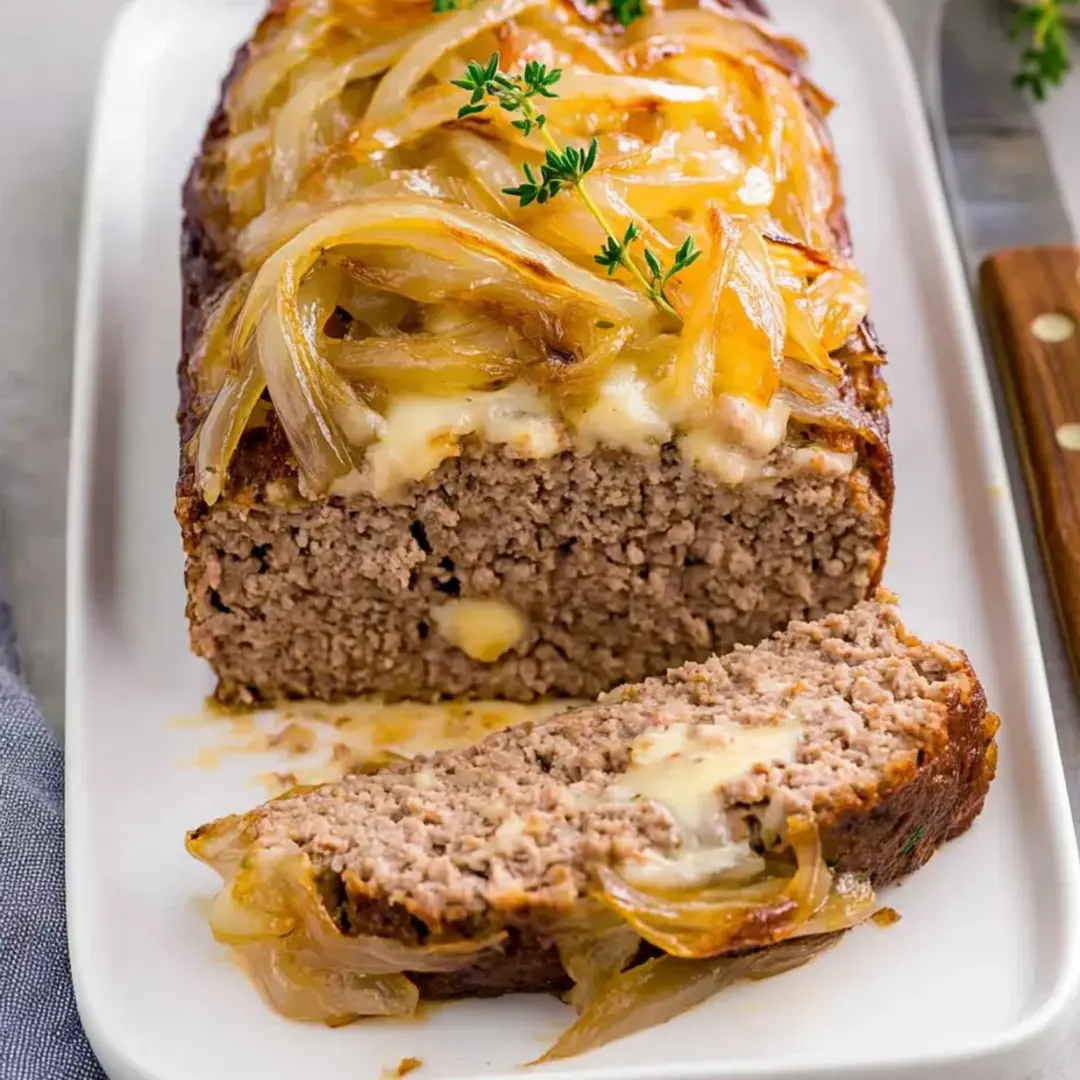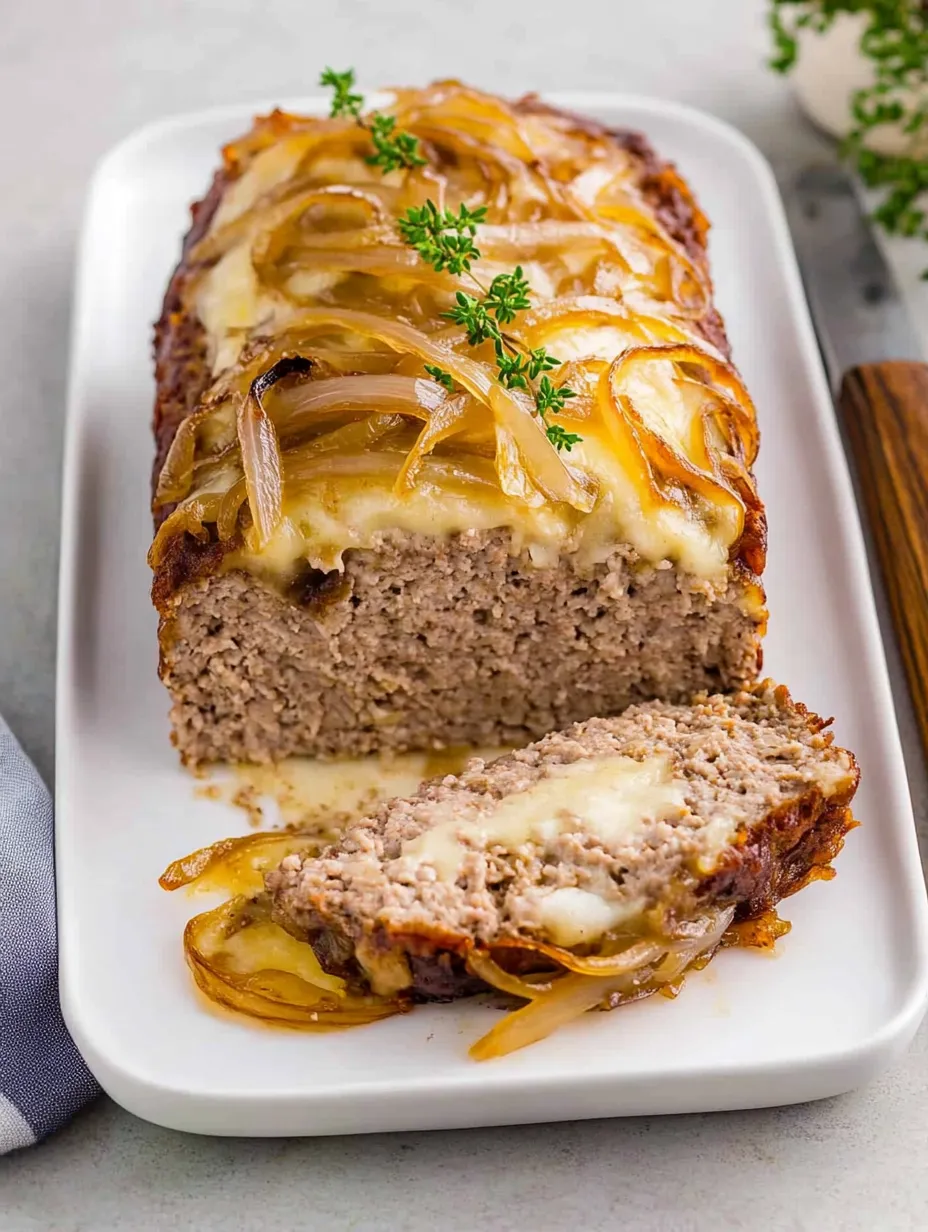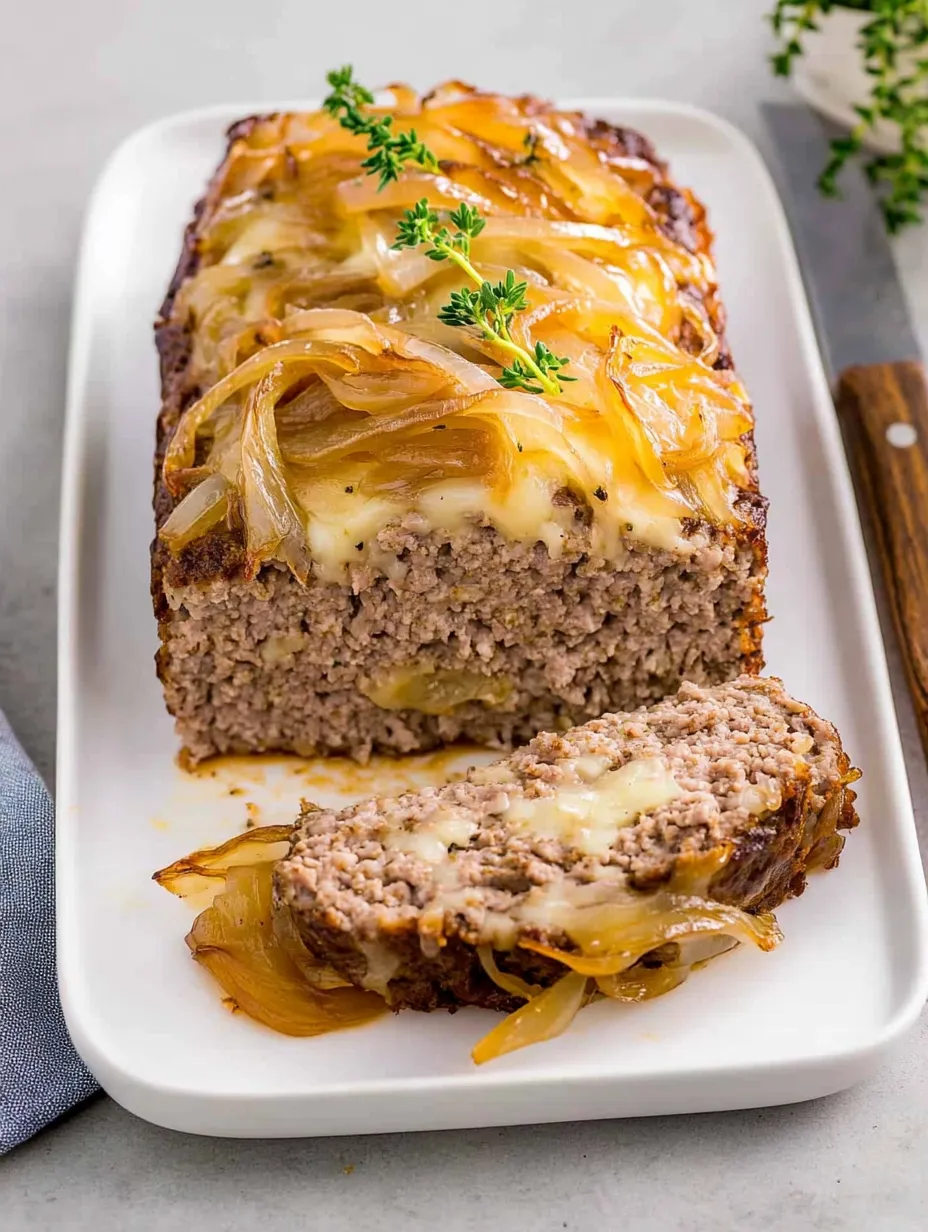 Pin it
Pin it
This innovative French Onion Meatloaf transforms two beloved comfort foods into one extraordinary dish that satisfies on every level. Tender, juicy ground meat forms the perfect canvas for sweet, slowly caramelized onions and nutty Gruyere cheese that melts beautifully over the top. The addition of fresh thyme infuses each slice with aromatic herb notes that perfectly complement the rich onion flavor. This isn't just meatloaf—it's an elevated culinary experience that maintains all the comforting qualities of the classic while introducing sophisticated French onion soup flavors that make each bite truly memorable. Best of all, with only 2.6g of carbs per serving, it fits perfectly into a keto lifestyle without sacrificing an ounce of flavor.
I first created this recipe during a particularly cold winter when my family was growing tired of our regular meatloaf rotation. The first time I served it, my husband took one bite and looked up in surprise. "This is meatloaf?" he asked, before reaching for seconds before he'd even finished his first helping. My teenage son, who typically picks at protein-heavy meals, cleared his plate and asked if there was more. Now it's requested so frequently that I often caramelize extra onions on the weekend to have them ready for midweek cooking—a small time investment that makes this spectacular meal possible even on busy weeknights.
Key Ingredients
- Ground beef and pork: This 50/50 combination creates the perfect balance of flavor and juiciness; the beef provides robust taste while the pork adds moisture
- White onions: When properly caramelized, they transform from sharp and pungent to meltingly sweet and rich; yellow onions work equally well
- Gruyere cheese: Its nutty, slightly sweet flavor perfectly complements the caramelized onions while offering superior meltability
- Fresh thyme: Provides aromatic, earthy notes that cut through the richness of the meat and cheese; dried thyme can work in a pinch but lacks the same bright flavor
- Crushed pork rinds: Creates the perfect binding texture without adding carbs; they disappear into the mixture while helping it hold together
- Butter: The foundation for proper caramelization, allowing the onions to develop their sweet complexity without burning
- Egg: Provides crucial structure, helping the meatloaf hold together when sliced
 Pin it
Pin it
Detailed Cooking Instructions
- Step 1:
- Begin by caramelizing the onions, which is the foundation of this recipe's exceptional flavor. In a large skillet over low heat, melt 2 tablespoons of butter. Using low heat is crucial here—too high and the onions will brown and crisp rather than slowly caramelize.
- Step 2:
- Add 2 cups of thinly sliced white or yellow onions to the melted butter, tossing to ensure each piece is coated. Sprinkle with ¼ teaspoon of salt, which helps draw out moisture and accelerate the caramelization process. The salt also enhances the natural sweetness that will develop.
- Step 3:
- Cook the onions with patience, stirring frequently to prevent any from sticking or burning. This process takes about 15-20 minutes and cannot be rushed. You'll know they're ready when they've reduced significantly in volume and turned a rich golden-brown color with a soft, almost jam-like consistency.
- Step 4:
- Once the onions have caramelized, stir in 1 tablespoon of fresh thyme leaves, allowing them to release their aromatic oils with the residual heat. Cook for just one additional minute, then remove the skillet from heat and set aside to cool slightly. Properly cooled onions won't cook the egg when mixed into the meat.
- Step 5:
- Preheat your oven to 350°F (175°C) and line a large rimmed baking sheet with parchment paper for easy cleanup. The rimmed sheet catches any juices that might otherwise cause smoking in your oven.
- Step 6:
- In a large mixing bowl, combine 1 pound ground beef and 1 pound ground pork. The mixture should have visible marbling from the fat, which will render during cooking to keep the meatloaf moist and flavorful.
- Step 7:
- Add 1 cup crushed pork rinds to the meat mixture. The finer the crush, the more seamlessly they'll incorporate. They serve as a zero-carb binder that disappears texturally but helps the meatloaf hold its shape.
- Step 8:
- Season the mixture with 1 teaspoon onion powder, ½ teaspoon black pepper, and 1 teaspoon salt. The onion powder reinforces the French onion flavor profile even in bites that might not contain caramelized onions.
- Step 9:
- Add one large egg to the bowl, then incorporate half of your caramelized onions, reserving the remainder for topping. The distribution of ingredients is important here—mixing half into the meat infuses flavor throughout, while reserving half for topping creates a beautiful presentation.
- Step 10:
- Using clean hands (the most effective tool for this job), gently but thoroughly combine all ingredients until just evenly distributed. Overmixing can result in a dense, tough texture, so stop once everything is incorporated.
- Step 11:
- Transfer the meat mixture to your prepared baking sheet and form it into a loaf approximately 5 by 9 inches. A free-form loaf on a baking sheet allows better heat circulation than a loaf pan, resulting in more even cooking and better caramelization on the exterior.
- Step 12:
- Bake the meatloaf for 40-50 minutes, until an instant-read thermometer inserted into the center registers 160°F (71°C). This temperature ensures food safety while maintaining juiciness. If you don't have a thermometer, look for clear juices when you insert a knife into the center.
- Step 13:
- Once the meatloaf reaches temperature, remove it from the oven and turn the oven off. Immediately top the hot meatloaf with 1 cup shredded Gruyere cheese and the remaining caramelized onions, distributing them evenly across the surface.
- Step 14:
- Return the topped meatloaf to the still-warm oven for about 5 minutes, just long enough for the cheese to melt beautifully over the top. The residual heat is perfect for melting the cheese without furthering cooking the meat.
- Step 15:
- Allow the meatloaf to rest for 10-15 minutes before slicing. This critical resting period allows the juices to redistribute throughout the meat instead of running out when cut, ensuring each slice remains moist and flavorful.
- Step 16:
- Slice into thick portions using a sharp knife, wiping the blade between cuts for the cleanest presentation. Serve warm, perhaps with a sprinkle of additional fresh thyme for garnish.
The Art of Caramelizing Onions
The soul of this French Onion Meatloaf lies in properly caramelized onions, a process that cannot be rushed but delivers incomparable results. What happens during caramelization is actually quite fascinating – the natural sugars in the onions break down and concentrate as moisture evaporates, transforming their sharp, pungent flavor into something deeply sweet and complex. The key is maintaining a low, consistent heat and having patience. I've found that slicing the onions uniformly (about ⅛-inch thick) helps them caramelize evenly. While some recipes suggest adding sugar to speed up the process, I avoid this – natural caramelization produces more nuanced flavors. One time-saving tip I've discovered is that caramelized onions keep beautifully in the refrigerator for up to five days, so I often make a large batch on weekends to have ready for quick weeknight cooking.
 Pin it
Pin it
Make-Ahead and Storage Tips
This meatloaf fits beautifully into meal prep routines and actually improves with a bit of time. The caramelized onions can be prepared up to three days ahead and refrigerated in an airtight container, making the final assembly much quicker. The entire meatloaf mixture can be combined and shaped a day ahead, stored covered in the refrigerator, and baked just before serving. Once baked, leftovers maintain their flavor and texture remarkably well for up to four days when refrigerated in an airtight container. For reheating, I recommend using a 325°F oven rather than a microwave – about 15 minutes covered with foil preserves the moisture while gently warming the meatloaf through. The lower temperature prevents the proteins from tightening further and becoming tough, keeping each slice as juicy as when first baked.
Serving Suggestions for a Complete Meal
While this French Onion Meatloaf certainly stands proud as the star of any dinner, thoughtful sides can create a memorable meal experience. For keto diners, cauliflower mash makes a perfect accompaniment – the creamy texture and mild flavor provide an excellent canvas for the meatloaf's rich juices. A bright, vinegar-based coleslaw offers refreshing contrast to the savory depth of the meatloaf. For those not counting carbs, roasted garlic mashed potatoes echo and complement the sweet onion flavors in the meatloaf. A simple green salad dressed with a Dijon vinaigrette adds a peppery, acidic element that cuts through the richness beautifully. Whatever sides you choose, be sure to factor in the meatloaf's satisfying richness when planning portion sizes – its flavor profile is robust enough that modest servings leave diners fully satisfied.
I discovered completely by accident that a tablespoon of Dijon mustard mixed into the meat adds incredible depth without tasting mustardy at all. One day I was making this recipe and realized I was out of onion powder, so I substituted Dijon mustard on a whim. The resulting flavor was so good that I now add both ingredients every time I make it!
This French Onion Meatloaf has become my signature dish – the one friends request when they visit and the recipe most frequently shared from my kitchen. There's something deeply satisfying about transforming humble ingredients into something that tastes so sophisticated. Each time I serve it, watching people's expressions as they take that first bite reminds me why I love cooking – food has the power to surprise, delight, and bring people together around the table. Whether you're following a keto lifestyle or simply appreciate a good meatloaf, this recipe promises to deliver comfort food elevated to new heights.
Frequently Asked Questions
- → Can I make this meatloaf ahead of time?
- Yes! You can prepare the meatloaf mixture and form it into a loaf up to 24 hours ahead. Cover and refrigerate until ready to bake. The caramelized onions can also be made in advance and refrigerated separately.
- → What can I substitute for Gruyere cheese?
- Swiss cheese is the closest substitute, but you could also use provolone, fontina, or even mozzarella. Each will give a slightly different flavor profile, but all will work well with the caramelized onions.
- → Is this recipe truly keto-friendly?
- Yes, with only 2.6g of carbs per serving, this meatloaf fits perfectly into a ketogenic diet. The recipe uses either ground pork rinds or almond flour instead of traditional breadcrumbs to keep the carb count low.
- → How do I store leftover meatloaf?
- Store leftovers in an airtight container in the refrigerator for up to 4 days. This meatloaf also freezes well - wrap individual slices tightly and freeze for up to 3 months. Thaw in the refrigerator before reheating.
- → What side dishes pair well with this French Onion Meatloaf?
- For a keto-friendly meal, serve with cauliflower mash, roasted Brussels sprouts, or a simple green salad. If you're not following keto, traditional mashed potatoes or crusty bread would also pair beautifully.
